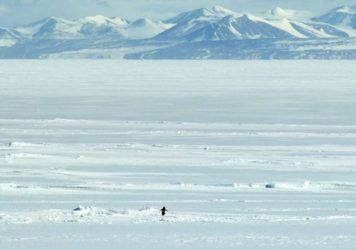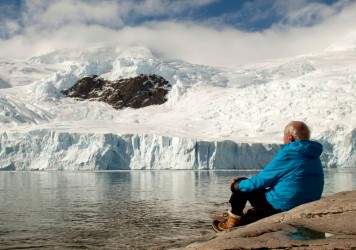As an observational study of people and place, Werner Herzog’s documentary is truly fascinating.
If you saw 2005’s The Wild Blue Yonder, perhaps you’re wondering why Werner Herzog is returning to Antarctica. That film was a starkly inventive synthesis of fact and fiction that saw Brad Dourif star as an alien from Andromeda. It features an intriguing interplay between previously unseen footage shot by NASA astronauts, and stunning underwater photography from McMurdo Sound in Antarctica (standing in for Dourif’s homeworld).
But clearly, Herzog wasn’t satisfied. While the Antarctic scenes from The Wild Blue Yonder were shot by DP Henry Kaiser, this time the director has made his own way to the ‘End of the World’, eager to explore the continent for himself.
This being Herzog, however, Encounters at the End of the World isn’t your average Antarctic documentary. Where most filmmakers come looking for shots of cute animals, “my questions about nature,” he tells us, “were different.” He’s not kidding.
In a voiceover that sets the tone for the film’s odd mix of black comedy and poignant inquiry, Herzog explains that he wants to know why monkeys don’t saddle up gazelles and ride off into the sunset; or whether penguins can lose their mind. This intellectual curiosity was enough to secure him a spot on a research plane, though quite what the boffins in charge made of his questions, we never find out.
What follows is a personal take on the Antarctic wilderness. Landing in McMurdo, the main research station for assorted scientists, dreamers and existential drifters, Herzog is initially disappointed with what he finds. McMurdo is an ugly blot on the landscape – the worst bits of the West served cold – but he soon escapes to the hinterland; disappearing down caves, diving through sink holes, and trekking up the side of active volcanoes.
Along with regular DP Peter Zeitlinger, Herzog has captured some arresting images, especially underwater. We see thousands of clams arrayed in silent worship at the foot of an iceberg; seals swimming against a shimmering sunlit backdrop of neon blue; and prehistoric creatures emerging out of midnight waters. Though the original score from Henry Kaiser tries a bit too hard to induce a sense of wonder, when Herzog switches to an echoing soundtrack of seal cries like alien sonar, the effect is indeed awe-inspiring.
After Grizzly Man, The Wild Blue Yonder and even Rescue Dawn, Herzog again explores the callous reality of nature, and the way it both threatens and enriches our lives. Though his narration often reaches for the poetic, he has an unsentimental perspective of nature’s cruelty. In the film’s most poignant moment, he lingers on a penguin walking away from the sea. The penguin is almost comic in its determination to defy the laws of nature, until Herzog reminds us that it walks to certain death. The silence that follows is as still and cold as an Antarctic dawn.
And yet… Maybe we’ve been spoiled by the BBC’s peerless Natural History Unit, but anybody who’s seen Planet Earth will find plenty that’s familiar in the landscapes of Encounters. What really makes the film unique, then, is its cast of bizarre and beguiling characters. If Antarctica is at the bottom of the world, it’s the place where all the people who’ve fallen through the cracks inevitably collect.
There’s Libor Zicha, the utility mechanic who was once imprisoned and now keeps a rucksack packed (complete with inflatable dinghy), ready to hit the road. There’s Stefan Pashkov, forklift philosopher; David Pacheco, a plumber descended, he tells us, from Incan kings; and William Jirsa, the linguistic genius who burned his Ph D and headed south.
It’s their lives and stories that bring meaning to an unknowable place, although the picture is complicated by Herzog’s oddly aggressive attitude. He talks contemptuously of ‘absurd quests’ (this from the director of Fitzcarraldo) and ‘tree huggers’, which seems a strange prejudice to take to the ground zero of environmental activism.
But maybe that is a testament to Herzog’s own freeform spirit of inquiry. He has journeyed, literally, to the ends of the earth for the simple pleasure of seeing what’s there. That is itself a quest, but as Encounters proves, it’s far from absurd.
Published 23 Apr 2009
Herzog versus the Antarctic. It’s too tight to call.
As a nature documentary it’s nothing special. But that was never the intent. As an observational study of people and place, it’s truly fascinating.
Has Herzog’s unique imprint all over it, and raises questions that deserve careful consideration.

By Tim Cooke
Encounters at the End of the World features one of the great existential moments in modern cinema.

Two writers make their case for the most eccentric moment in the director’s career.

Mr March of the Penguins returns with an affecting, unhysterical film about the ensuing climate disaster ahead.